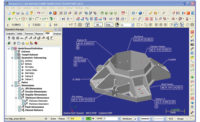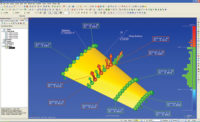How many engineering print changes does a company typically do on a given project? For that matter, how many are done on an average piece part and what does each print change cost the project? Engineering changes can cost between $1,000 and $2,500 for even the simple changes.
This same question can be asked of changes throughout the project starting at the design phase on through pre-production or prototype, first-article inspection, on the manufacturing floor and assembly line all the way to the customer and the end user. Obviously the answers to these questions would show that these changes get more expensive the further the project goes. Some of the largest contributors to the causes of these changes occur early in the ‘Concept to Mass Production’ process. With this knowledge, manufacturers could avoid the costly changes in the first place.
Over the past several decades, statistical process control (SPC) has been a growing concern in the manufacturing world. While it is true that process controls are a necessity, and much can be learned from the analysis of statistical data, many of the problems that are encountered in the process of bringing a product from concept to production could be avoided, and not repeated project after project, by employing the dimensional management plans from the beginning of the conceptual design stage. The solution is geometric dimensioning and tolerancing (GD&T), but for some reason, it seems to take a major dimensional mismanagement catastrophe for most companies to understand this fact.
A typical flawed process
The typical design-to-manufacture process at most companies goes something like this:
1. A company recognizes the need for a product to perform a particular function.
2. The company begins conceptual design.
3. Design personnel develop 3-D (sometimes 2-D) computer-aided design (CAD) models of the concept such as designs with nominal dimensions without tolerances, or with only “title-block” and “critical” tolerances expressed.
4. A “best shot” is taken at producing the parts to the nominal CAD model.
5. Prototypes are tested, tweaked, shaved, bent or whatever needs to be done to the part to make it work in an optimal way for the desired function. These manipulations are often done with little or no documentation.
6. Based on feedback from the suppliers and inspection, tolerances are altered to fit “what the supplier can hold,” with each change requiring an engineering change notice, rather than what is truly necessary for function. This step is usually the one where the design personnel first feel that it is time to ‘GD&T the drawing.’ This step is usually repeated throughout the manufacturing life of the product in a continuous attempt to get higher Cpk values, among other reasons.
Problems that arise throughout this process are dealt with on a case-by-case, “firefighting” style and usually result in many iterations. The design is then considered “complete” and from that point forward, everyone in the process is supposed to control all their processes so that nothing ever changes—no one ever gets sick, retires or changes jobs, and there is no tool wear, machine failure or operator error.
Using a methodology such as that outlined above will normally result in parts that work as intended, but with many hidden, and some not-so-hidden, costs that could have been avoided with proper dimensional management in place from the conceptual design stage.
So what is proper dimensional management? It involves thinking through the concepts in a functional manner, determining the appropriate tolerances required for the function of the part, and then communicating those tolerances in a standardized way to all who need to know them, such as manufacturing and inspection personnel. Of course, appropriate statistics and indexes should be monitored and calculated to ensure that those true design requirements are actually being met, but the real challenge is determining those true requirements and communicating them in a standardized manner.
A better way
The “Concept to Mass Production” process should look more like this:
1. Recognize the need for a product to perform a particular function.
2. Begin conceptual design by contemplating functional datum structures from the beginning. Design engineering does this while creating the CAD models, not after.
3. Prove the concept through prototyping, and document, in a standardized manner, any changes to the prototypes that were needed for proper form, fit and function.
4. Perform initial detail design where we select functional datum features and qualify them to be stable and repeatable enough by the maximum functionally allowable tolerances to them. This step may require taking action as shown in step 6.
5. Continue with detail design where the maximum functionally allowable tolerances are determined for all size features, both datum features and considered features, including appropriate material condition modifiers.
6. Perform tolerance stack-up analyses and performance testing to determine the true design requirement, or the maximum functionally allowable tolerance values.
7. Communicate these tolerances in a standardized way to ensure the preservation of the substantial work done in steps 4 to 6.
8. Get approval from all parties including manufacturing, metrology, purchasing, sales, management, quality and design for production release.
Regular design reviews should be conducted from the beginning of the conceptual design stage. These reviews should include representatives from design, manufacturing, metrology, purchasing, sales and management. Doing so will allow the concurrent development of realistic manufacturing and inspection plans.
Notice the need for standardization in the communication of the design requirements, starting at the conceptual stage and continuing throughout the entire process. Many standards are available for use, but the most widely used is the Dimensioning and Tolerancing standard published by the ASME. The current version is ASME Y14.5M-1994. Actually, that is the standard to which most people are referring when they say, “Geometric Dimensioning and Tolerancing,” or, “GD&T.” The reality is that the entire series of the Y14 standards are being used in some way whenever engineering prints are created.
The major problem most companies, and even individuals, have with making the best use of these standards is that they don’t commit the time and effort necessary for all the people who have to use them to actually learn them. Becoming truly fluent in any language is difficult and takes time and effort to accomplish. Becoming truly fluent in the language of a technical communication standard is just as difficult, but the benefits are manifold.
Using GD&T from the beginning of a design is not a panacea, and will not rid a company of all manufacturing and inspection problems. But using GD&T from the start, thinking in “GD&T-eeze,” if you will, coupled with actually calculating (or doing performance-testing and R&D to determine) the truly functional tolerances required for a design, certainly has the potential to drastically reduce the number of iterations, and therefore engineering changes, necessary throughout the life of the product.
Subhead: Tech Tips
1. Engineering changes on new products can be costly, especially if changes are required throughout the product launch.
2. While products may work if GD&T is not done early in the process, many hidden costs may not be revealed.
3. Regular design reviews allow for concurrent development of realistic manufacturing and inspection plans.

